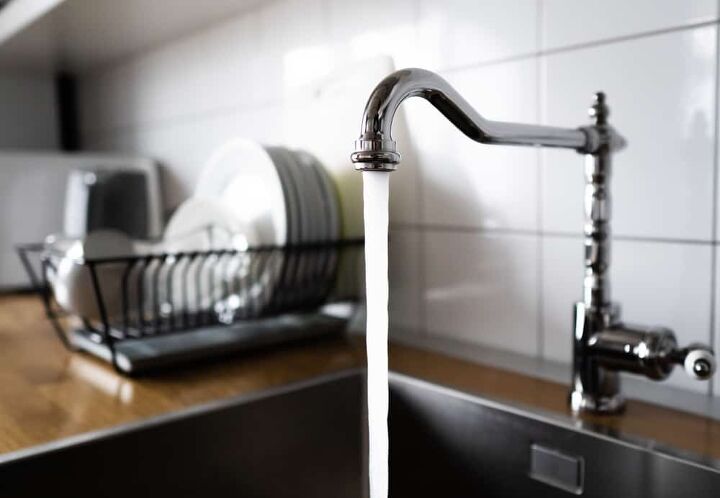Why Is Hot Water Coming Out Of The Cold Tap? (Find Out Now!)

Imagine turning on the cold water spigot and seeing steam coming out with the water after a couple of minutes. You’ll likely wonder if you turned on the wrong tap, then wonder how the water lines got crossed. How can the hot water be flowing out of the cold water tap?
There are a number of possible reasons the hot water is flowing from the wrong tap. They can range from pipes being too close together, a recirculating plumbing characteristic, or improper heat trap installation. It could also be affected by ventilation ducts, copper piping, too much water pressure, or thermostat woes.
Once you determine the cause, you can find the right course of action to correct it. Some solutions will correct themselves, while others may require troubleshooting and adjustment. Having a plumber check things out is your best course of action.
Do You Need to Hire a Plumber?
Get free, zero-commitment quotes from pro contractors near you.

Are My Pipes Too Close Together?
Pipe proximity is one cause of hot water flowing out of the cold water tap. When pipes run parallel and are seated too closely, heat can pass from the hot water side to the cold. This heats the water in the cold water lines, producing warm to lukewarm water.
Cold water can also heat up by being too close to a water heater or forced-air heating duct. When the supply lines sit too closely to these heat sources, the radiant heat transfers to the cold-water pipes. This affects the water temperature flowing through the adjacent water lines though the effects are often temporary.
Adequate pipe layout and spacing is a more proactive solution to this particular issue. It is much more costly to reconfigure and retrofit an existing pipe system than build an efficient one from scratch. The best way to combat this is by insulating the pipes to help protect the internal temperature and prevent heat transfer.
What Is the “Copper Heating Effect”?
The proximity issue magnifies when copper is the plumbing material installed. Copper pipes are usually the most effective at retaining heat, which makes them the more desirable choice. The drawback of choosing copper is that any radiant heat transfer holds longer and warms up the cold water supply.
Fortunately, the “copper heating effect” is temporary; only the water inside the water line pipe has warmed up. Since there is cold water sitting in the tank, you can correct this by turning on the cold-water tap. The warmed water in the line eventually passes through as you let the cold water run.
Insulating copper piping is even more critical on copper lines, particularly if they are also seated too closely. Wrapping the pipes not only limits heat transfer between lines but makes heat conduction more effective. Protection from damage and temperature extremes are added bonuses, as well as boosting energy efficiency and water conservation.
Is the Heat Trap Installed Properly?
When plumbers install a water heater, there’s a valve or loop that’s part of each water intake line. These sections, called heat traps, allow cold water to flow into the water heater tank while preventing unwanted hot water. The heat traps ensure that the correct water temperature flows from its designated tap.
The heat trap operates by having an internal flapper or ball block the hot-water flow to the cold-water line. Occasionally, the flapper might misalign, or the ball could wear down and pass through the valve nest inside the trap. Realigning the flapper or ball inside the heat trap will stop the hot water from flowing at the wrong time.
Most newer water heaters have built-in heat traps, while older models may have independent sections installed at the water line. A missing or incorrectly installed part at the water inlet might allow hot water to mix into the cold-water tap. Checking the connection seal or installing a heat trap will keep the hot water out of the wrong water line.
What Is a Recirculating Plumbing System?
Some plumbing systems feature a setup that quickly moves hot water to household fixtures and cuts out the wait time. Unlike water systems that rely on low water pressure, these recirculating systems employ a hot water pipe loop. The loop continuously circulates hot water, which is readily available on-demand via a short feeder pipe to the tap.
This circuit heats the water intermittently and returns the hot water to the water heater through the cold water pipes. This process can result in a temporary heating of the cold water supply. Fortunately, it is only temporary and the water returns to normal temperature once the hot water passes through.
How Does the Water Expansion Tank Factor In?
Because water can’t compress, it needs some space inside the water heater to expand without building excess pressure. This is the function of the water expansion tank, usually a smaller tank installed on the water heater’s water supply. The air inside the expansion tank compresses, allowing the expanding heated water to flow into it and manage water pressure.
A one-way valve in the water meter relieves pressure and restricts hot water flow into the cold supply. If too much pressure builds up inside the expansion tank, it could strain or even rupture the valve’s seal. Should the pressure cause the valve to fail, hot water could leak into the cold water pipes.
Tankless water heaters operate in a similar fashion, but the expansion tank may not be immediately adjacent to it. Therefore, you’ll need to locate the expansion tank to determine if it is the culprit. A skilled do-it-yourselfer could complete this simple repair, but it’s probably smarter to have a plumber handle it.
Is My Thermostat Working?
It’s possible that the hot water leaching stems from the heat source itself: the thermostat. Electric water heater thermostats operate an immersion heater inside the main tank, which heats the water for use. The thermostat monitors the tank’s water temperature and regulates when the immersion heater comes on according to its settings.
If the thermostat shorts or just physically breaks, the immersion rod could run continuously and overheat the entire tank. Not only could this trigger high water pressure, but the water will overheat and spill into the cold water supply. Any water pulled through the taps will be warmer than usual because of this.
Of course, the surest way to repair a faulty thermostat is to call a licensed professional to do the job. However, it is possible to troubleshoot on your own if you are proactive about electrical safety and carefully follow instructions. A voltmeter, nut driver, screwdrivers, and a replacement thermostat are all you need to test and replace it safely.
Do You Need to Hire a Plumber?
Get free, zero-commitment quotes from pro contractors near you.

Related Questions
How do I keep cold water pipes from getting hot?
Insulating the water supply pipes is key for preventing heat transfer from hot to cold. How you go about insulating the pipes depends on your climate and protection goals. There are merits to insulating both supply lines and several different methods to shield them from temperature fluctuations.Insulating the hot water supply pipes blocks the radiant heat from the cold water lines and helps lower energy costs. Insulating cold water supply lines helps eliminate pipe sweating and humidity, thus preventing potential pipe condensation, drips, and puddles. Foam pipe sleeves or strips of pipe wrap and the easiest and most energy-efficient insulation choices for protecting water lines.Additional insulation methods that help keep the pipes well insulated include wall insulation, gap sealant, and weatherproof outdoor spigot covers. These techniques work to keep extreme outdoor temperatures from seeping indoors and reaching the plumbing lines. Having these extra layers of protection will greatly decrease the amount of heat transfer between supply lines.
How hot should water be at the tap?
We enjoy the availability of hot water and its uses in bathing and cleaning. In using hot water, we must be mindful that its temperature delivers at a safe temperature to prevent burn injuries. Therefore, it’s a general rule that 120 degrees Fahrenheit be the maximum safe water temperature circulating through a water fixture.
Why does my hot water not stay hot?
We’ve all known the frustrating–and often shocking–feeling of running out of hot water before the end of a shower. Pinpointing why your hot water supply runs out can involve anything from power supply problems or various plumbing line errors. Most causes will lie in troubleshooting your water heater for possible solutions.You should first investigate any power issues before you disassemble anything on your water meter. It could be as simple as relighting a pilot light or checking the breaker–or that the unit is turned on. If none of these work, you’ll need to test the thermostat after taking the necessary safety precautions.Once power sources are ruled out, you’ll need to check your water tank for internal issues. Sediment on the tank floor or a broken dip tube restricts the water heater’s ability to provide sufficient on-demand water. Regular cleaning and maintenance keep the water heater running properly and provide an ample hot water supply.
More Related Guides

Stacy Randall is a wife, mother, and freelance writer from NOLA that has always had a love for DIY projects, home organization, and making spaces beautiful. Together with her husband, she has been spending the last several years lovingly renovating her grandparent's former home, making it their own and learning a lot about life along the way.
More by Stacy Randall



























